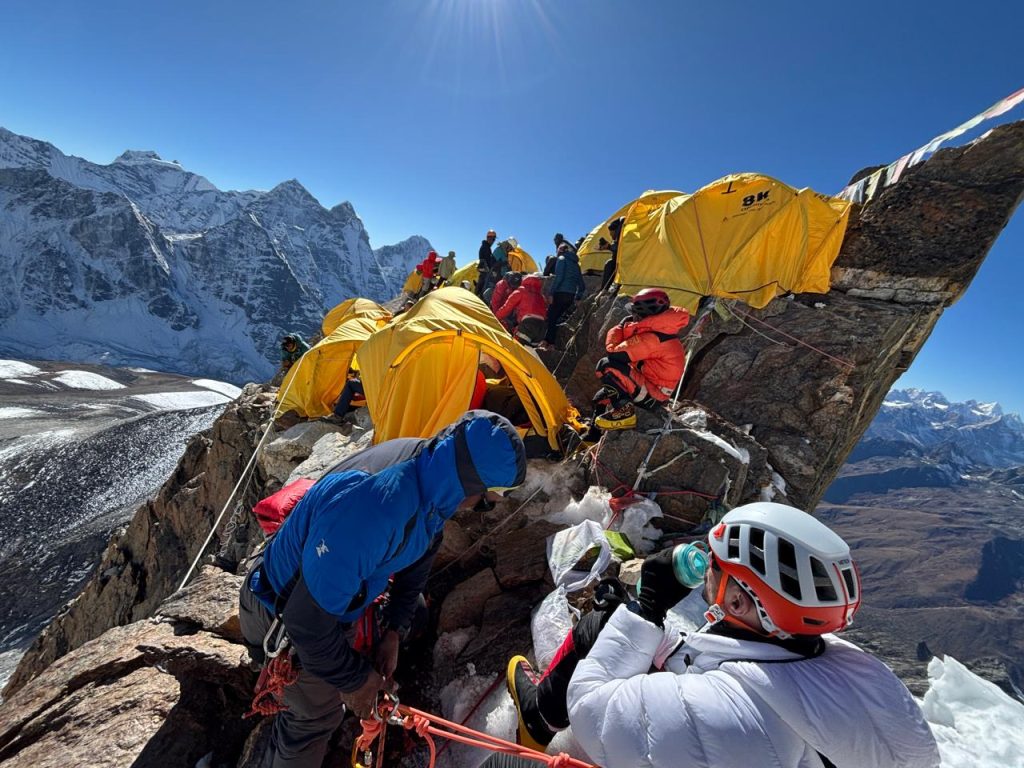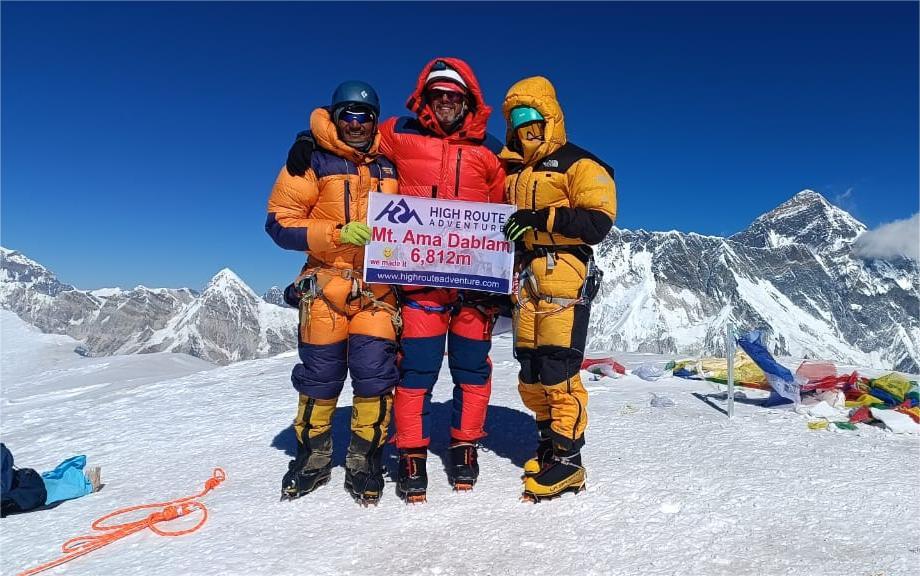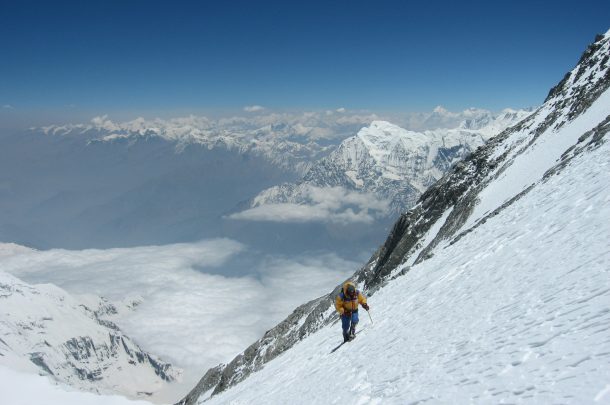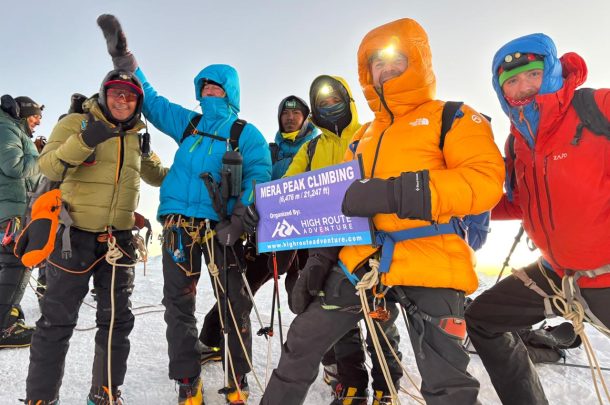The Ama Dablam Expedition with High Route Adventure is a remarkable mountaineering journey that encapsulates the essence of adventures in the heart of the Himalayas! Ama Dablam, often referred to as the “Matterhorn of the Himalayas” due to its distinctive pyramid shape, offers climbers a challenging yet rewarding ascent. The route to its summit is a test of technical skill, physical endurance, and unwavering determination! Are you ready?
The climb begins at Base Camp, nestled in the shadow of Ama Dablam, at an elevation of approximately 4,600 meters (15,092 feet). From here, climbers embark on an arduous journey that takes them through a series of high-altitude camps. The Advanced Base Camp (ABC), situated at around 5,639 meters (18,500 feet), serves as the launching point for the expedition’s higher reaches.
As climbers ascend, they traverse rocky terrains, negotiate steep ridges, and face the challenges of snow and ice. Camp I, also known as “The Yak Camp,” at about 5,700 meters (18,700 feet), offers the first significant rest stop! From there, they advance to Camp II, or “The Advanced Camp,” perched at approximately 6,000 meters (19,685 feet) on a narrow snow ridge. It’s here that climbers intensify their acclimatization efforts and prepare for the more demanding sections ahead.
High Route Adventure’s expert climbing guides continue with you to Camp III, known as “The Summit Camp,” at around 6,480 meters (21,260 feet). This camp is strategically placed just below Ama Dablam’s southwest ridge, making it the final camp before the summit push!
The ascent to the summit, standing tall at 6,812 meters (22,349 feet), is the Major highlight of the Ama Dablam expedition. Climbers must navigate technical rock and ice sections, employing their skills and determination to reach the pinnacle of Ama Dablam’s majestic Himalayan pyramid!
To conquer Ama Dablam, one must be equipped with a comprehensive arsenal of gear and equipment tailored to the requirements of high-altitude mountaineering in Nepal! In contrast to standard hiking gear, this expedition demands specialized tools and gear.
Crampons with precision-engineered spikes provide essential traction on icy surfaces, while harnesses with safety features offer peace of mind on tricky rock faces. Ice axes, designed for balance and power, are indispensable for navigating steep slopes and ice formations. Furthermore, altitude-resistant clothing, constructed with cutting-edge materials, ensures climbers remain warm and safe in the ever-changing Himalayan weather.
These tools are not mere accessories; they are lifelines, enabling climbers to conquer the unforgiving terrain of Ama Dablam. Climbers who embark on this expedition are advised to have some prior experience. Proficiency in rock and ice climbing is a benefit, as is the ability to utilize ropes and anchors!
Mt Ama Dablam is renowned for its formidable challenges. Its distinctive pyramid shape presents a complex medley of rock, snow, and ice obstacles. The exposed ridges and sheer rock faces demand a level of technical skill. With the help of High Route Adventure, you’ll navigate steep sections with finesse, employing a blend of rock and ice climbing techniques.
The thin air at high altitudes adds another layer of complexity, requiring climbers to acclimatize gradually and make calculated decisions to ensure their safety and success.
The timing of the expedition is an important consideration! The optimal seasons for the Mt Ama Dablam expedition are autumn/fall (October-November) and spring (April-May). During these months, the weather tends to be more stable, with clear skies and manageable temperatures.
Embarking on the climb during other times of the year exposes climbers to harsh and unpredictable weather conditions, significantly increasing the risk associated with the ascent. Timing, therefore, is a factor that can make the difference between a successful summit and a perilous retreat!
Check: Best Time for Ama Dablam ExpeditionThe journey begins at the base camp, situated at approximately 4,600 meters (15,092 feet) above sea level. This is the starting point for climbers and serves as the hub for organizing equipment, acclimatization, and initial briefings. High Route Adventure sets up our main camp here. It also provides a stunning vantage point for viewing Ama Dablam’s majestic pyramid shape!
After training at base camp, climbers ascend to the advanced base camp, located at around 5,400 meters (17,716 feet). This camp is strategically positioned closer to the mountain and serves as a launch pad for further ascents. Climbers typically spend several days here, acclimatizing to the increasing altitude and preparing for the more challenging sections ahead.
Often referred to as “The Yak Camp,” is situated at approximately 5,700 meters (18,700 feet) above sea level. It is the first high camp along the route, marking a significant step in the ascent. Climbers establish this camp on a rocky terrace and use it as a resting point during their climb. From here, the route becomes steeper and more technical.

Called “The Advanced Camp,” Camp II is positioned at approximately 6,000 meters (19,685 feet). It is a critical waypoint in the climb and is nestled on a narrow snow ridge. Climbers may spend several nights here, adjusting to the altitude and preparing for the challenging sections ahead. Camp II offers breathtaking views of the surrounding Himalayan peaks.
Also known as “The Summit Camp,” it is situated at around 6,480 meters (21,260 feet) above sea level. This camp is strategically located just below the mountain’s southwest ridge. It is the final camp before the summit push and requires a technical climb to reach. Climbers typically set off from here in the early hours of the morning for their summit attempt.

The ultimate goal of the expedition is to reach the summit of Ama Dablam, which stands at an impressive 6,812 meters (22,349 feet) above sea level. The summit push is the most challenging part of the climb, often involving technical rock and ice sections. Success at the summit is a testament to the climber’s skill, determination, and preparation!
Traveler’s note: Thamel houses most trekking shops, restaurants, hotels, and boutique handicraft shops. Here you’ll find anything and everything you need for a successful summit climb up Mt Ama a Dablam!
Traveler’s note: For dinner options, we recommend one of the local restaurants, a staple dish of Nepal is the traditional dumpling called MoMo, absolutely delicious. Thamel has also a lot of options for international cuisine for you to choose from. For any recommendations, we’ll be happy to provide you.
Traveler’s note: Also known as one of the most unique airports in the world, the landing and take-offs from Lukla are heart-racing!
Traveler’s note: The Sagarmatha or Everest National Park entry point is Monjo village, hence the permit check post! While traversing around Larja Dobhan you’ll have a chance to see your first views of Mt Everest from the viewpoint!
Traveler’s note: Did you know that Namche Bazaar from a distance looks like a horseshoe? Here you can find many restaurants, pharmacies, and even luxury resorts!
Traveler’s note: Also used to trek towards the Lakes of Gokyo in the western region of Everest Phortse also serves as a crossroad for trekkers.
Traveler’s note: While entering the Imja Valley today it is common to see lots of yak herds. The next day we have our second and last acclimatization day.
Traveler’s note: Did you know that from tomorrow we veer off the Everest Base Camp trail, and head east towards the foot of Mt Ama Dablam? It officially marks the last day of trekking and the start of the expedition. The views from Chukung Ri are incredible, on clear days you get to see a great part of the entire Everest region’s mountain peaks such as Island Peak, Nuptse, etc!
Traveler’s note: Pay good attention during the climbing class, the next day we’ll hold a practice climb towards the Advance Base Camp and back. Take a good rest as tomorrow you’ll set your first steps on the massif Mt Ama Dablam!
Traveler’s note: Today’s section is more about acclimatization and getting a feel for the route and technical sections. Take your time with today’s climb and take in the view as you ascend higher up the mountain.
Traveler’s note: Our expert High Route Adventure climbing team takes the day to teach you invaluable techniques, pay attention as these can greatly help you overcome the obstacles lying in wait as we try to reach further up the mountain! During this day our team will also set up camp in Advance Base Camp anticipating your arrival.
Ama Dablam takes you to an altitude of 6800 which is a massive altitude and the chances of getting altitude sickness are also high. Therefore before embarking on this climbing journey, you need to learn about the symptoms of altitude sickness and its preventive measures.
To deal with the altitude we have made the 25 days perfect Itinerary plans where there will be enough days for the acclimatization. You can check our itinerary in detail so that you can know on which day you will be doing the acclimatization for your safety and to make the climbing experience smooth.
For the meals while staying in the city area you need to pay on your own and during the trekking time we will manage the three meals for you. While staying in the tent our chef will cook a simple delicious three times meal for you.
While staying in the tea house the food will be simple and you will not have the wide variety of food that you can find on the menu of a city restaurant. You can have breakfast between 6-8 am in the morning. The breakfast you can expect is Tibetan Bread, Pancakes, Cereals, Paratha, French toast, vegetarian soup, or eggs.
For Lunch and dinner, you get the common food like traditional Dal Bhat, Momo, Thukpa or Thentuk, Chow Mein or Noodles, Fried Rice, Rice and Curry, Pizza, Pasta or Spaghetti etc. You can have lunch between 11 am to 1 pm and dinner from 7 to 9 p.m.
Also, you can get a variety of tea and alcoholic beverages in the tea house. For the alcoholic beverage, you need to pay on your own.
In the city area of Kathmandu, you can find numerous types of accommodation depending upon your choice and budget. The rooms are equipped with modern technology and facilities like wifi, air conditioner, and fully equipped bathrooms are available.
On the trekking trail of the Ama Dablam Expedition, you will be staying in the tea house which is limited in number. The rooms are basic and in some places, you need to share the room with fellow trekkers. There is no AC and no heating insulation inside the room. Rooms are not private, as they are partitioned by plywood. Also, the dining is shared among the travelers and the bathroom is also often shared. Most of the toilets are of squat types. Very few amenities are available in the tea house. There are the facilities of the wifi, hot shower and the electricity for charging but you need to pay the extra cost for use.
As the number of trekkers is increasing day by day the number of tea houses is also increasing. Presently, some of the tea houses offer better facilities equipped with modern technology to enhance the trekking experience.
Since you will be staying in the tent for nearly two weeks for the Ama Dablam Expedition, our team will manage the tent for you. High Route Adventure will provide you with all the climbing equipment such as a good quality tent( sleeping, toilet, dining), kitchen utensils, table, chair, mattresses, and sleeping bags.
Climbing Ama Dablam is best during the month of spring and autumn seasons due to favourable trekking conditions. The climbing journey will be more adventurous and it is safer to trek during this season.
Autumn seasons: Due to moderate temperature, clear view of the sky, and stable weather conditions, this season is considered as the best time for climbing Ama Dablam Expedition. You can get the perfect view of the landscape and the surrounding mountain making an ideal time for climbing. Also during the autumn season, some big festivals(Dashain, Tihar) coincide, adding you to immerse in a cultural experience.
Spring seasons: The spring season is also known as the blooming season. During the month of the spring season, you can find beautiful flowers blooming everywhere. Also, the national flower of Nepal rhododendron blooming in the high altitude of the forest area adds beauty to the trek. The stable weather conditions and less chance of rainfall make this season another best time to climb the Ama Dablam Expedition.
We have an Ama Dablam exploration team which consists of well–trained guides, porters, and technical staff who are always ready to offer any assistance that will make your experience not only safe but also enjoyable. We are composed of well-trained and knowledgeable members who have an in-depth exploration of the trekking path, local conventions, and safety guidelines.
They will provide help, directions, and backup throughout the hike, such as meditating and carrying gear, and sharing information about the flora and fauna that you will encounter on your way. The expertise of our team will be with you as you go along your way to Ama Dablam expedition and you get there without worry and anxiety.
All the tea houses are equipped with the wifi and electricity which you can find on the trekking trail of the Ama Dablam Expedition. The cost of the wifi and charging the electric appliance while staying in the tea house requires you to pay some cash which will be around 2-3$ per hour.
After leaving the tea while staying in the tent there will be no wifi available. For charging the electric appliance you can use a solar panel or generator. In case of an emergency, our sherpa guide will provide you with a satellite phone.
Climbing at the high altitude area of Mount Ama Dablam means there are certain types of risk associated. You need to deal with the high altitude areas, difficult landscapes, walking in the technical area of the base camp, weather changes, and some unpredicted natural disasters that can occur.
So to prepare for emergency medical evacuation, health safety, and to be secure and tension-free, having travel insurance is a must for every climber. Before making the travel insurance make sure it covers important things such as helicopter evacuation, medical, flight cancellation, etc. Also, keep in mind that you cannot have travel insurance here in Nepal so before leaving your home country make sure to have it.
You need to obtain the climbing permit for the Ama Dablam Expedition from the Nepal Mountaineering Association(NMA). A climbing permit for the Ama Dablam Expedition will cost you 400$ (in the spring and fall) and (During the Winter and Monsoon) $200. You need to also obtain a TIMS Card which will cost you around 20$. And another Sagarmatha National Park Pass is also required which will cost you around 28 $.
Since you will be climbing through our trekking agency you don’t need to worry about getting this permit, we will arrange all this climbing permit, TIMS Card, and national park permit for you.
After you arrive at the International Airport of Nepal(TIA) you will be welcomed and received by our trekking agency representative. Then you will drive from the airport to the hotel in our private vehicle. Similarly, for the departure, you will be taken to the airport 3 hours before your scheduled flight by our staff. The cost of the transportation will be included in the package.
Everything You Need to Pack for a Safe and Successful Climb
Climbing Ama Dablam (6,812m) is both rewarding and demanding. The right gear can make all the difference in your comfort, safety, and summit success. Here's a carefully crafted checklist of equipment you’ll need for the full expedition—from base camp to the summit.
Base Layers (Next to Skin):
Mid Layers (Insulation):
Outer Layers (Wind/Water Protection):
High-Altitude Summit Gear:



